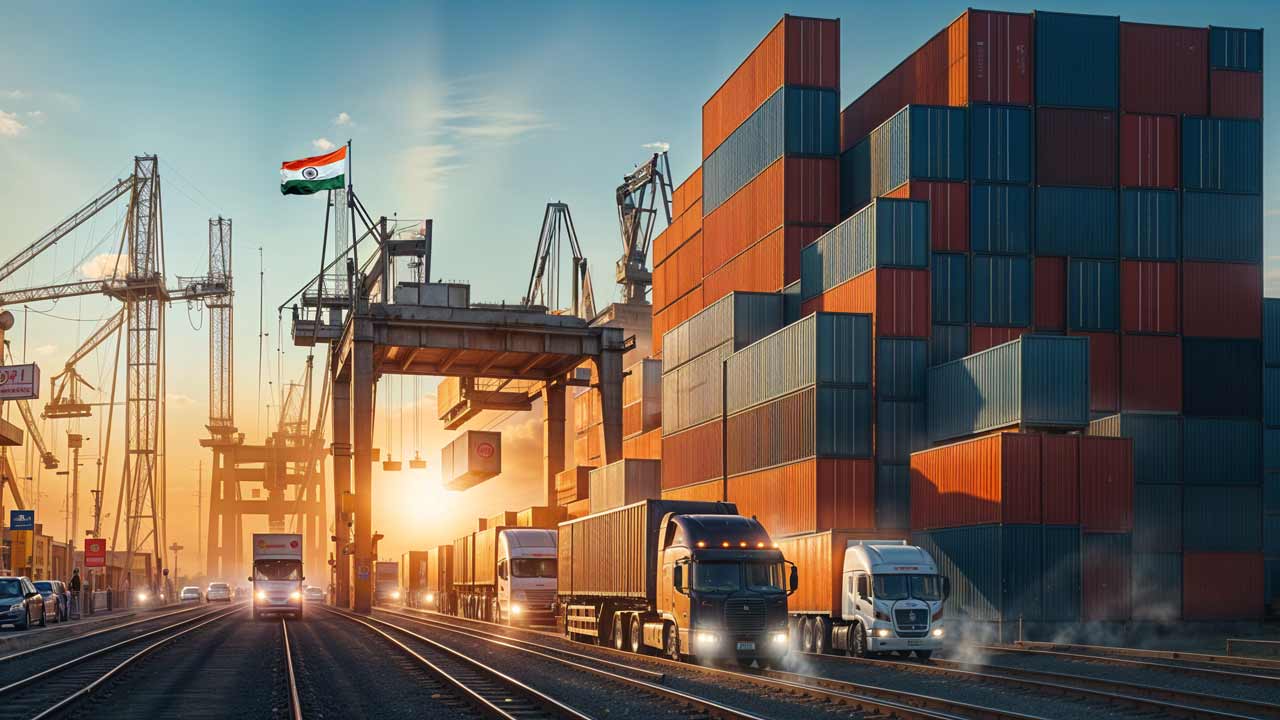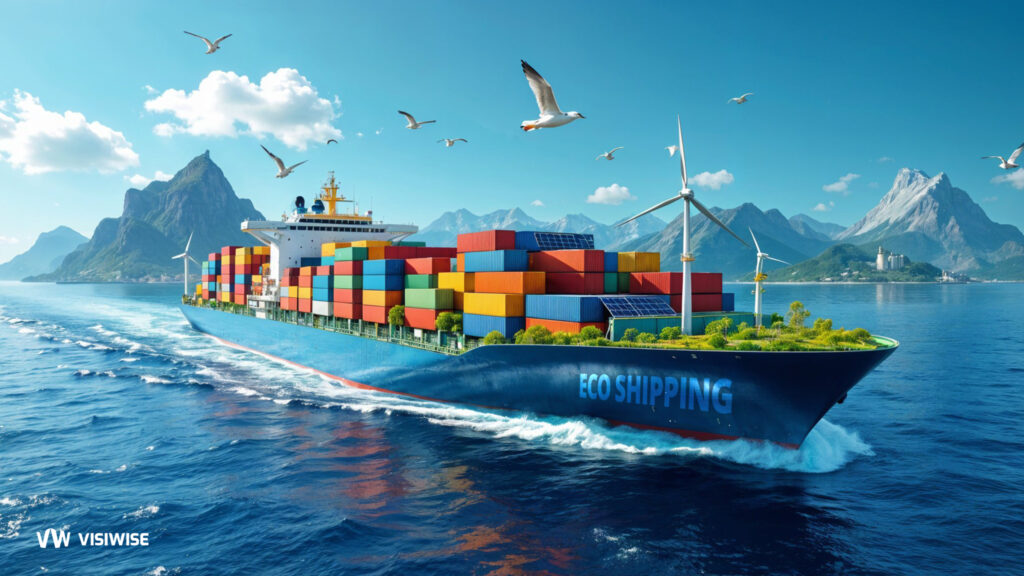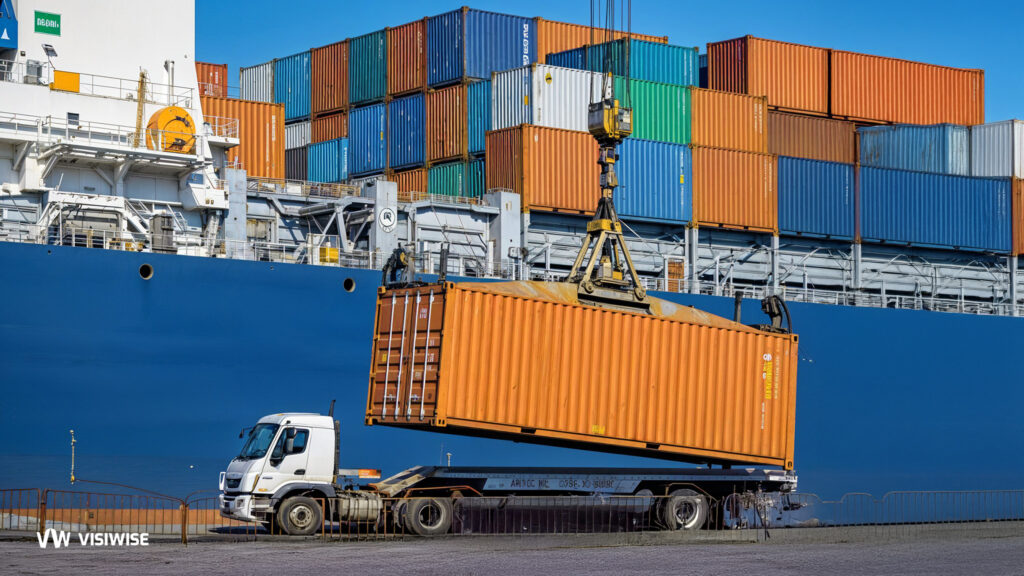In the rapidly evolving landscape of global trade, India has emerged as a significant player, driven by its robust logistics infrastructure. Central to this infrastructure are Inland Container Depots (ICDs) and Container Freight Stations (CFSs), which play crucial roles in the efficient handling, storage, and transportation of goods. These facilities are pivotal in streamlining the movement of cargo between seaports and the hinterland, ensuring that goods reach their destinations smoothly and on time.
As the demand for efficient logistics and supply chain management grows, the need for real-time visibility becomes increasingly important. Real-time visibility platforms offer unprecedented transparency and control over cargo movements, enabling stakeholders to track and monitor shipments throughout their journey. This article explores the significance of ICDs and CFSs in India, the adoption of real-time visibility technologies, and the transformative impact these technologies have on the logistics sector.
Understanding ICDs and CFSs
What are ICDs?
Inland Container Depots (ICDs) are essentially dry ports located inland from seaports. They act as intermediaries between seaports and hinterlands, enabling the handling and temporary storage of import and export cargo. ICDs are equipped to handle customs clearance, making them a crucial link in the logistics chain. They serve as an extension of the seaport into the hinterland, reducing congestion at the ports and providing a more streamlined process for cargo movement.
What are CFSs?
Container Freight Stations (CFSs) are facilities where containers are stuffed, de-stuffed, and temporarily stored. Unlike ICDs, CFSs are typically located near seaports and operate under the jurisdiction of customs authorities. CFSs handle both import and export cargo, facilitating the consolidation and deconsolidation of shipments. They provide essential services such as cargo inspection, customs clearance, and storage.
Roles and Benefits of ICDs and CFSs
Enhancing Logistics Efficiency
ICDs and CFSs enhance logistics efficiency by decentralizing cargo handling from congested seaports. This decentralization allows for faster and more organized cargo movement, reducing delays and improving turnaround times. By distributing the cargo handling workload, these facilities help prevent bottlenecks and optimize the supply chain.
Customs Clearance
One of the significant advantages of ICDs and CFSs is their ability to handle customs clearance processes. This capability streamlines the import-export procedures, allowing for quicker and more efficient processing of goods. Importers and exporters benefit from reduced lead times and lower costs associated with customs clearance at these facilities.
Cost-Effectiveness
ICDs and CFSs contribute to cost-effectiveness in logistics operations. By providing facilities closer to the cargo origin or destination, transportation costs are reduced. Additionally, these facilities often offer warehousing and storage solutions, allowing businesses to optimize their inventory management and reduce storage costs.
Supporting Trade Growth
The presence of ICDs and CFSs supports trade growth by providing the necessary infrastructure for handling increased cargo volumes. As India continues to expand its trade activities, these facilities play a crucial role in accommodating the growing demand for efficient logistics services. They facilitate the smooth movement of goods, contributing to the overall growth of the economy.
Regulatory Framework Governing ICDs and CFSs
Customs Act, 1962
The primary legislative framework governing ICDs and CFSs in India is the Customs Act, 1962. This act provides the legal basis for the establishment, operation, and regulation of these facilities. Under this act, the Central Board of Indirect Taxes and Customs (CBIC) is responsible for overseeing the customs procedures and operations at ICDs and CFSs.
Guidelines and Notifications
The CBIC issues guidelines and notifications from time to time to regulate the functioning of ICDs and CFSs. These guidelines cover various aspects such as the licensing process, operational requirements, and compliance standards. The aim is to ensure that these facilities operate efficiently and in compliance with customs regulations.
Role of the Indian Railways
The Indian Railways plays a significant role in the operation of ICDs. Many ICDs are connected to the rail network, facilitating the movement of cargo between seaports and inland locations. The Indian Railways provides the necessary infrastructure and services for the transportation of containers to and from ICDs, enhancing the overall efficiency of the logistics chain.
Public-Private Partnerships
The development and operation of ICDs and CFSs in India often involve public-private partnerships (PPPs). The government collaborates with private players to establish and manage these facilities, leveraging private sector expertise and investment. This collaborative approach helps in the efficient development and operation of ICDs and CFSs, ensuring that they meet the evolving needs of the logistics industry.
Challenges Faced by ICDs and CFSs
Infrastructure Constraints
Despite their critical role, ICDs and CFSs face several challenges. One of the primary challenges is infrastructure constraints. Many facilities lack the necessary infrastructure to handle large volumes of cargo efficiently. Inadequate road and rail connectivity, limited storage space, and outdated equipment hinder the smooth functioning of these facilities.
Regulatory Hurdles
Regulatory hurdles pose another significant challenge for ICDs and CFSs. Complex and cumbersome regulatory procedures can lead to delays in customs clearance and other operations. Additionally, frequent changes in regulations and policies create uncertainty for operators, impacting their ability to plan and execute their operations effectively.
Technology Adoption
The adoption of advanced technologies in ICDs and CFSs is often limited. Many facilities still rely on manual processes, leading to inefficiencies and delays. The lack of investment in technology infrastructure such as automated handling systems, digital documentation, and tracking systems hampers the overall efficiency of these facilities.
Security Concerns
Security concerns are also a major issue for ICDs and CFSs. Ensuring the safety and security of cargo during handling and storage is crucial. However, inadequate security measures, lack of surveillance systems, and insufficient monitoring mechanisms can lead to theft, pilferage, and other security breaches.
Future Prospects and Developments
Infrastructure Upgradation
To address the challenges faced by ICDs and CFSs, there is a growing focus on infrastructure upgradation. The government and private sector are investing in the development of modern infrastructure, including better road and rail connectivity, expanded storage facilities, and advanced handling equipment. These upgrades will enhance the capacity and efficiency of ICDs and CFSs, enabling them to handle larger volumes of cargo.
Technology Integration
The integration of advanced technologies is crucial for the future of ICDs and CFSs. The adoption of digital solutions such as automated handling systems, electronic documentation, and real-time tracking will streamline operations and improve efficiency. Technologies like blockchain, IoT, and AI can revolutionize the logistics industry by enhancing transparency, reducing delays, and optimizing resource utilization.
Regulatory Reforms
Regulatory reforms are essential to create a conducive environment for the operation of ICDs and CFSs. Simplifying and streamlining customs procedures, reducing bureaucratic red tape, and providing clear guidelines will facilitate smoother operations. Consistent and transparent policies will encourage investment and participation from private players, driving the growth of these facilities.
Focus on Sustainability
Sustainability is becoming a key consideration in the development and operation of ICDs and CFSs. There is an increasing emphasis on adopting eco-friendly practices and technologies to minimize the environmental impact of logistics operations. Sustainable practices such as energy-efficient infrastructure, waste management, and the use of renewable energy sources will contribute to the long-term viability of these facilities.
Expansion of Network
The expansion of the ICD and CFS network is vital to meet the growing demand for logistics services. The government is working towards establishing more ICDs and CFSs across the country, especially in strategic locations with high trade potential. This expansion will enhance the accessibility and reach of these facilities, ensuring that they can cater to the needs of various industries and regions.
Collaboration and Partnerships
Collaboration and partnerships between the government, private sector, and other stakeholders are crucial for the success of ICDs and CFSs. Public-private partnerships can drive the development and operation of these facilities, leveraging the expertise and resources of both sectors. Collaborative efforts will lead to better planning, implementation, and management of ICDs and CFSs, ensuring that they meet the evolving needs of the logistics industry.
Case Studies of Successful ICDs and CFSs in India
Tughlakabad ICD
The Tughlakabad ICD in Delhi is one of the largest and most significant ICDs in India. Operated by the Container Corporation of India (CONCOR), this facility handles a substantial volume of import and export cargo. With its strategic location and excellent connectivity to major seaports and industrial hubs, the Tughlakabad ICD plays a crucial role in facilitating trade and logistics operations.
Chennai CFS
The Chennai CFS, located near the Chennai Port, is a prime example of an efficiently operated CFS. This facility provides comprehensive services including cargo handling, customs clearance, and storage. With its advanced infrastructure and technology integration, the Chennai CFS ensures smooth and efficient cargo movement, contributing to the overall efficiency of the logistics chain.
ICD Patli
ICD Patli, situated in Haryana, is another successful ICD that has significantly contributed to the logistics sector. This facility, developed under a public-private partnership, offers a range of services including container handling, storage, and customs clearance. ICD Patli’s strategic location and excellent connectivity to the Delhi-NCR region make it a vital logistics hub.
CFS Jawaharlal Nehru Port Trust (JNPT)
The CFS operated by Jawaharlal Nehru Port Trust (JNPT) near Mumbai is one of the busiest and most efficient CFSs in India. This facility handles a significant volume of containerized cargo, providing essential services such as cargo consolidation, deconsolidation, and customs clearance. With its state-of-the-art infrastructure and advanced technology, the JNPT CFS ensures seamless cargo movement and efficient logistics operations.
Real-Time Visibility Tracking in ICDs and CFSs
The adoption of real-time visibility tracking platforms in Inland Container Depots (ICDs) and Container Freight Stations (CFSs) is increasingly becoming a crucial aspect of modern logistics. Real-time visibility enables stakeholders to track the movement and status of cargo through digital platforms, providing transparency and efficiency in the supply chain. Here’s a detailed look at how ICDs and CFSs in India are integrating real-time visibility tracking platforms and the benefits they offer.
Current State of Technology Adoption
- Implementation of Digital Platforms: Many ICDs and CFSs in India have started implementing digital platforms that provide real-time tracking of cargo. These platforms utilize technologies such as GPS, RFID (Radio Frequency Identification), and IoT (Internet of Things) to monitor and report the location and status of containers.
- Integration with Customs Systems: Some facilities have integrated their tracking systems with customs authorities’ digital systems, allowing for real-time updates on customs clearance status. This integration helps in reducing delays and streamlining the customs process.
- Use of Port Community Systems (PCS): Port Community Systems (PCS) are being used to facilitate real-time data exchange among stakeholders involved in port and terminal operations. PCS platforms, like PCS1x implemented by the Indian Ports Association, offer visibility into container movements and streamline information flow between shipping lines, port operators, customs, and other stakeholders.
Benefits of Real-Time Visibility
- Enhanced Transparency and Accountability: Real-time tracking platforms provide stakeholders with up-to-date information on the status and location of their cargo. This transparency builds trust and accountability among all parties involved in the supply chain.
- Improved Operational Efficiency: Real-time data allows ICDs and CFSs to optimize their operations by predicting and managing congestion, planning resources better, and reducing dwell times. Efficient operations lead to cost savings and improved turnaround times.
- Better Decision-Making: Access to real-time information enables stakeholders to make informed decisions quickly. Whether it’s rerouting a shipment due to unforeseen delays or adjusting inventory levels based on current cargo status, real-time visibility supports proactive decision-making.
- Enhanced Security: Tracking platforms often come with security features such as tamper alerts and geofencing. These features help in preventing theft and ensuring the safety of cargo during transit and storage.
- Customer Satisfaction: Real-time visibility provides customers with accurate information about their shipments, leading to improved customer satisfaction. Customers can track their shipments and receive notifications about delays or expected arrival times.
Challenges and Solutions
- Technology Integration: Integrating real-time tracking technology with existing systems at ICDs and CFSs can be challenging. Solutions include adopting standardized protocols and investing in compatible hardware and software that can seamlessly integrate with current infrastructure.
- Cost of Implementation: The initial cost of implementing real-time tracking platforms can be high. However, the long-term benefits such as reduced operational costs, improved efficiency, and enhanced customer satisfaction can outweigh these initial expenses. Public-private partnerships and government incentives can also support these investments.
- Training and Adoption: Ensuring that staff at ICDs and CFSs are adequately trained to use these new technologies is crucial. Ongoing training programs and workshops can help in smooth adoption and utilization of real-time tracking systems.
Future Prospects and Developments
Expansion of Real-Time Tracking Systems
- Wider Adoption: Wider adoption of real-time tracking systems across all ICDs and CFSs in India is expected as the benefits of transparency, efficiency, and security become increasingly apparent. Both public and private stakeholders are recognizing the value of investing in these technologies to stay competitive in the global logistics market.
- Advanced Technologies: The integration of advanced technologies like artificial intelligence (AI), machine learning (ML), blockchain, and big data analytics is anticipated to further enhance real-time visibility platforms. These technologies can provide predictive analytics for better decision-making, enhanced security through immutable records, and more efficient handling of large datasets to optimize operations.
Government Initiatives and Policies
- Policy Support: The Indian government is likely to continue supporting the implementation of real-time tracking technologies through favorable policies and initiatives. For instance, the introduction of the National Logistics Policy aims to streamline logistics processes and promote the use of digital technologies, including real-time tracking systems.
- Incentives and Subsidies: Financial incentives and subsidies for the adoption of real-time tracking technologies can encourage more ICDs and CFSs to invest in these systems. This support can help mitigate the initial high costs of implementation and promote widespread adoption.
Collaboration and Standardization
- Collaborative Efforts: Collaboration between different stakeholders, including government bodies, logistics service providers, technology companies, and industry associations, will be crucial for the successful implementation and operation of real-time tracking systems. Joint efforts can lead to the development of industry standards, sharing of best practices, and addressing common challenges.
- Standardization: Developing and adopting standardized protocols for real-time tracking systems can facilitate seamless integration across different platforms and stakeholders. Standardization ensures compatibility and interoperability, which are essential for effective real-time visibility across the entire supply chain.
Training and Skill Development
- Workforce Training: Training and skill development programs for the workforce at ICDs and CFSs are essential to ensure the effective use of real-time tracking systems. Continuous education and upskilling initiatives can help employees stay updated with the latest technologies and best practices.
- Educational Partnerships: Partnerships with educational institutions and training organizations can help develop specialized courses and certifications in logistics and supply chain management, focusing on the use of real-time tracking technologies.
Case Studies of Successful Real-Time Visibility Implementations
DMICDC Logistics Data Bank (LDB)
The DMICDC Logistics Data Bank (LDB) project is an exemplary case of real-time visibility implementation. Using RFID technology, LDB provides end-to-end tracking of container movement across major ports and inland container depots in India. The platform offers stakeholders real-time data on container location and status, enabling efficient logistics planning and reducing transit times. The success of LDB highlights the potential benefits of real-time tracking systems in enhancing logistics efficiency and transparency.
CONCOR’s Tracking System
Container Corporation of India (CONCOR) has implemented a comprehensive real-time tracking system for its operations. Customers can track their containers in real-time through CONCOR’s website and mobile application. This system integrates GPS and RFID technologies to provide accurate and up-to-date information on container movements, improving customer satisfaction and operational efficiency. CONCOR’s initiative demonstrates the positive impact of real-time visibility on logistics operations and customer experience.
PCS1x by Indian Ports Association
The PCS1x platform by the Indian Ports Association is a state-of-the-art Port Community System that integrates various stakeholders in the maritime and logistics sectors. This platform offers real-time visibility into port operations, container movements, and customs clearance processes. By facilitating seamless information exchange and operational coordination, PCS1x enhances the efficiency and reliability of port and terminal operations. The success of PCS1x underscores the importance of digital platforms in modernizing India’s logistics infrastructure.
Wrap-up
Inland Container Depots (ICDs) and Container Freight Stations (CFSs) are pivotal for India’s logistics, enhancing efficiency, supporting trade, and expediting customs clearance. Despite challenges like infrastructure constraints and limited technology adoption, their future looks promising with upgrades, tech integration, and regulatory reforms. The expansion of the ICD and CFS network, alongside government-private sector collaboration, will cater to evolving industry needs, ensuring a smooth flow of goods and contributing to economic growth.
Simultaneously, real-time visibility tracking platforms are revolutionizing logistics in India, especially within ICDs and CFSs. These platforms offer benefits like transparency, efficiency, and enhanced security, promising a brighter future despite challenges like technology integration and costs. Continued investment in technology, government support, collaboration, and workforce training is crucial for success. By leveraging these advancements, India can bolster its logistics infrastructure, supporting trade ambitions and fostering economic prosperity.



